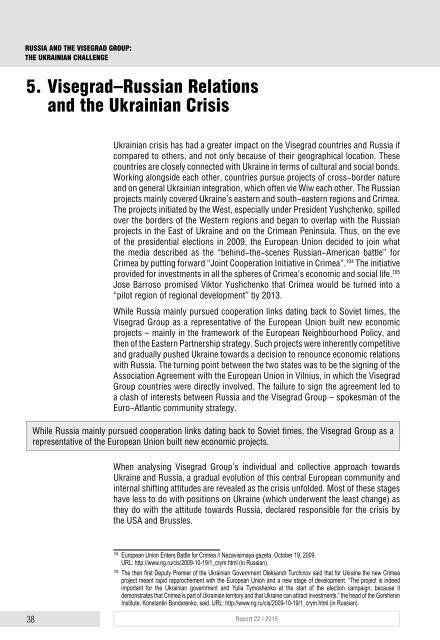RIAC-Visegrad-Report22-Eng
RIAC-Visegrad-Report22-Eng
RIAC-Visegrad-Report22-Eng
Create successful ePaper yourself
Turn your PDF publications into a flip-book with our unique Google optimized e-Paper software.
RUSSIA AND THE VISEGRAD GROUP:THE UKRAINIAN CHALLENGE5. <strong>Visegrad</strong>–Russian Relationsand the Ukrainian CrisisUkrainian crisis has had a greater impact on the <strong>Visegrad</strong> countries and Russia ifcompared to others, and not only because of their geographical location. Thesecountries are closely connected with Ukraine in terms of cultural and social bonds.Working alongside each other, countries pursue projects of cross-border natureand on general Ukrainian integration, which often vie Wiw each other. The Russianprojects mainly covered Ukraine’s eastern and south-eastern regions and Crimea.The projects initiated by the West, especially under President Yushchenko, spilledover the borders of the Western regions and began to overlap with the Russianprojects in the East of Ukraine and on the Crimean Peninsula. Thus, on the eveof the presidential elections in 2009, the European Union decided to join whatthe media described as the “behind-the-scenes Russian-American battle” forCrimea by putting forward “Joint Cooperation Initiative in Crimea”. 104 The initiativeprovided for investments in all the spheres of Crimea’s economic and social life. 105Jose Barroso promised Viktor Yushchenko that Crimea would be turned into a“pilot region of regional development” by 2013.While Russia mainly pursued cooperation links dating back to Soviet times, the<strong>Visegrad</strong> Group as a representative of the European Union built new economicprojects – mainly in the framework of the European Neighbourhood Policy, andthen of the Eastern Partnership strategy. Such projects were inherently competitiveand gradually pushed Ukraine towards a decision to renounce economic relationswith Russia. The turning point between the two states was to be the signing of theAssociation Agreement with the European Union in Vilnius, in which the <strong>Visegrad</strong>Group countries were directly involved. The failure to sign the agreement led toa clash of interests between Russia and the <strong>Visegrad</strong> Group – spokesman of theEuro-Atlantic community strategy.While Russia mainly pursued cooperation links dating back to Soviet times, the <strong>Visegrad</strong> Group as arepresentative of the European Union built new economic projects.When analysing <strong>Visegrad</strong> Group’s individual and collective approach towardsUkraine and Russia, a gradual evolution of this central European community andinternal shifting attitudes are revealed as the crisis unfolded. Most of these stageshave less to do with positions on Ukraine (which underwent the least change) asthey do with the attitude towards Russia, declared responsible for the crisis bythe USA and Brussles.104European Union Enters Battle for Crimea // Nezavisimaya gazeta, October 19, 2009.URL: http://www.ng.ru/cis/2009-10-19/1_crym.html (in Russian).105The then first Deputy Premier of the Ukrainian Government Oleksandr Turchinov said that for Ukraine the new Crimeaproject meant rapid rapprochement with the European Union and a new stage of development. “The project is indeedimportant for the Ukrainian government and Yulia Tymoshenko at the start of the election campaign, because itdemonstrates that Crimea is part of Ukrainian territory and that Ukraine can attract investments,” the head of the GorsheninInstitute, Konstantin Bondarenko, said. URL: http://www.ng.ru/cis/2009-10-19/1_crym.html (in Russian).38 Report 22 / 2015


